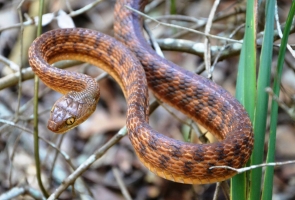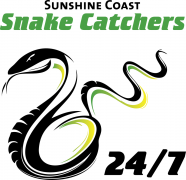
Significance to Humans:
Weakly venomous
There is discussion within the industry about the toxicity of their venom but most authorities believe that a bite from this species is considered minimal risk to all but young children. As with every venomous snake bite the appropriate first aid should be applied and medical help called.
General description:
Brown tree snakes have a slender body with a distinctly bulbous head which is well defined from a narrow neck. They have very large eyes with vertical pupils. Their colour generally stays consistent the the upper section of the body being brown to a reddish-brown or even dark orange, with irregular, indistinct darker cross-bands all over the body of the snake. Belly can be creamy colour but is often apricot or orange. Central row of mid-body scales running down the centre of the back larger than surrounding mid body scales. When they fee threatened they will hold their upper half of their body off the ground in a strong defensive “S” shaped posture. Midbody scales at 19 -23 rows. This species grows to be around 1.2 meters on average but specimens can reach up to 2 meters occasionally. They are a nocturnal species found at night unless of course they are disturbed from their hiding spot during the day. They like to hunt and eat small birds but also their eggs. They will also eat small mammals, frogs and other small reptiles.
Habitat in SE Qld:
Occupies a wide range of habitats from rainforest, wet and dry forests, woodland, heathland, melaleuca swamps and rocky outcrops, through to suburban backyards and gardens. Nocturnal, generally shelters during the day.
Around the home:
Occupies a wide range of habitats from rainforest, wet and dry forests, woodland, heathland, melaleuca swamps and rocky outcrops, through to suburban backyards and gardens. They are often found in roof spaces and will make the most of the shelter and abundance of rats and geckos up there to eat. They are nocturnal but often stumbled upon in garages or sheds sleeping during the day. They are a very skilled climber and are often found in the heavy foliage of trees and shrubs, in roofs, rafters and other above-ground environs. Commonly encountered when exploiting caged birds for an easy meal.
